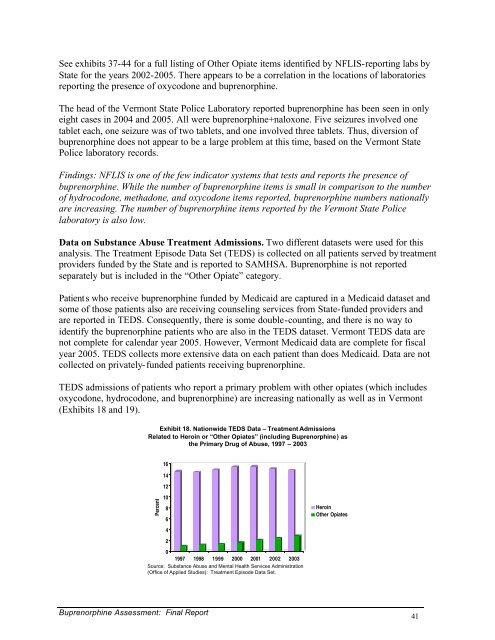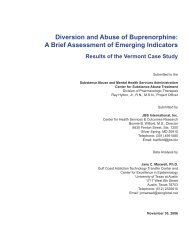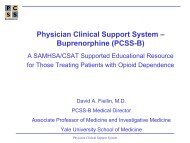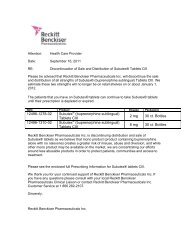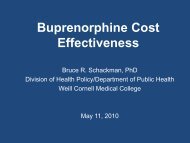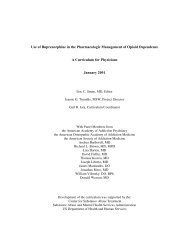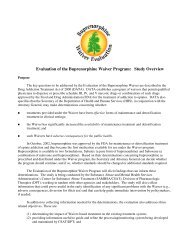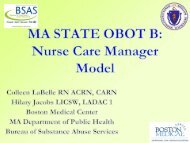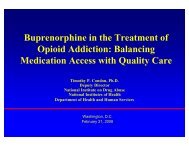Diversion and Abuse of Buprenorphine
Diversion and Abuse of Buprenorphine
Diversion and Abuse of Buprenorphine
You also want an ePaper? Increase the reach of your titles
YUMPU automatically turns print PDFs into web optimized ePapers that Google loves.
See exhibits 37-44 for a full listing <strong>of</strong> Other Opiate items identified by NFLIS-reporting labs by<br />
State for the years 2002-2005. There appears to be a correlation in the locations <strong>of</strong> laboratories<br />
reporting the presence <strong>of</strong> oxycodone <strong>and</strong> buprenorphine.<br />
The head <strong>of</strong> the Vermont State Police Laboratory reported buprenorphine has been seen in only<br />
eight cases in 2004 <strong>and</strong> 2005. All were buprenorphine+naloxone. Five seizures involved one<br />
tablet each, one seizure was <strong>of</strong> two tablets, <strong>and</strong> one involved three tablets. Thus, diversion <strong>of</strong><br />
buprenorphine does not appear to be a large problem at this time, based on the Vermont State<br />
Police laboratory records.<br />
Findings: NFLIS is one <strong>of</strong> the few indicator systems that tests <strong>and</strong> reports the presence <strong>of</strong><br />
buprenorphine. While the number <strong>of</strong> buprenorphine items is small in comparison to the number<br />
<strong>of</strong> hydrocodone, methadone, <strong>and</strong> oxycodone items reported, buprenorphine numbers nationally<br />
are increasing. The number <strong>of</strong> buprenorphine items reported by the Vermont State Police<br />
laboratory is also low.<br />
Data on Substance <strong>Abuse</strong> Treatment Admissions. Two different datasets were used for this<br />
analysis. The Treatment Episode Data Set (TEDS) is collected on all patients served by treatment<br />
providers funded by the State <strong>and</strong> is reported to SAMHSA. <strong>Buprenorphine</strong> is not reported<br />
separately but is included in the “Other Opiate” category.<br />
Patients who receive buprenorphine funded by Medicaid are captured in a Medicaid dataset <strong>and</strong><br />
some <strong>of</strong> those patients also are receiving counseling services from State-funded providers <strong>and</strong><br />
are reported in TEDS. Consequently, there is some double-counting, <strong>and</strong> there is no way to<br />
identify the buprenorphine patients who are also in the TEDS dataset. Vermont TEDS data are<br />
not complete for calendar year 2005. However, Vermont Medicaid data are complete for fiscal<br />
year 2005. TEDS collects more extensive data on each patient than does Medicaid. Data are not<br />
collected on privately-funded patients receiving buprenorphine.<br />
TEDS admissions <strong>of</strong> patients who report a primary problem with other opiates (which includes<br />
oxycodone, hydrocodone, <strong>and</strong> buprenorphine) are increasing nationally as well as in Vermont<br />
(Exhibits 18 <strong>and</strong> 19).<br />
<strong>Buprenorphine</strong> Assessment: Final Report<br />
Exhibit 18. Nationwide TEDS Data – Treatment Admissions<br />
Related to Heroin or “Other Opiates” (including <strong>Buprenorphine</strong>) as<br />
the Primary Drug <strong>of</strong> <strong>Abuse</strong>, 1997 – 2003<br />
Percent<br />
16<br />
14<br />
12<br />
10<br />
8<br />
6<br />
4<br />
2<br />
0<br />
1997 1998 1999 2000 2001 2002 2003<br />
Source: Substance <strong>Abuse</strong> <strong>and</strong> Mental Health Services Administration<br />
(Office <strong>of</strong> Applied Studies): Treatment Episode Data Set.<br />
Heroin<br />
Other Opiates<br />
41


